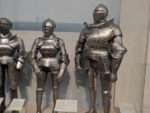The armors of Emperor and King Maximilian I and II, and King Louis II of Hungary


Emperor I Maximilian was the great Habsburg ruler who outlived King Matthias Corvinus. He was the one who brought about the Habsburgs’ rule in almost every corner of Europe. When the Hungarian Estates refused to give him the Sacred Crown of Hungary in 1505 under the pretext that he was not Hungarian, he scornfully remarked that he spoke Hungarian fluently and he was born in Bécsújhely (Wiener Neustadt) that had belonged to the Kingdom of Hungary. Moreover, he is said to have been related to the ancient Hungarian kings as well.
Regarding the Maximilian armor, it is still white armor, made in plain steel, but it is decorated with many flutings that may also have played a role in deflecting the points and blades of assailants and increasing the structural strength of the plates. It is a transitional stage in the decoration of armor, after the plain steel surfaces of 15th-century armor and before the elaborate decoration and coloring with etching and other techniques of Renaissance armor.
The Jousting Helmet (Sallet) of King Lajos II (Louis) of Hungary
As this helmet fits here in style, I decided to insert it here.


The portions of King Louis II’s Foot Combat Armor

Armorer: Conrad Seusenhofer (Austrian, Innsbruck, died 1517) Date: ca. 1515; Medium: Steel, leather;
Dimensions: as mounted: 55 7/8 × 25 9/16 × 10 5/8 in. (142 × 65 × 27 cm)
It is in the Metropolitan Museum of Arts, but not on view. Credit Line: Kunsthistorisches Museum, Vienna, Imperial Armoury / Sammlungen Schloss Ambras, Innsbruck.
Dear Readers, I can only make this content available through small donations or by selling my books or T-shirts.
If you like my writings, please feel free to support me with a coffee here:
You can check out my books on Amazon or Draft2Digital, they are available in hardcover, paperback, or ebook:
https://www.amazon.com/dp/198020490X
or at https://books2read.com/b/boYd81


My work can also be followed and supported on Patreon: Become a Patron!http://Become a Patron!














